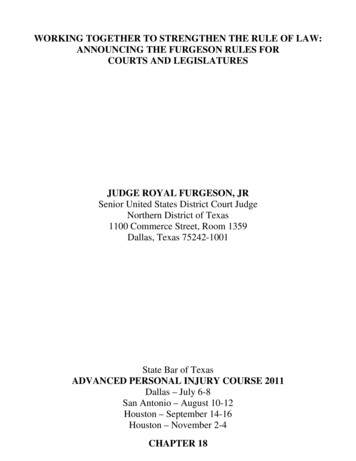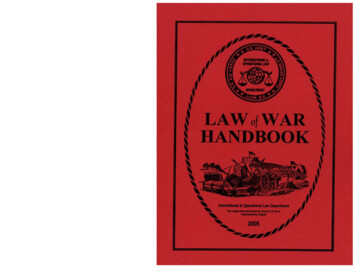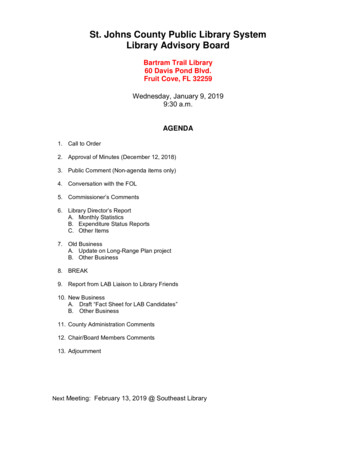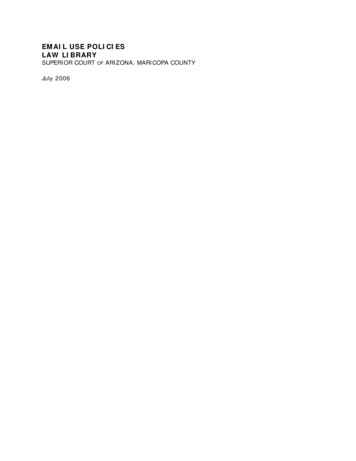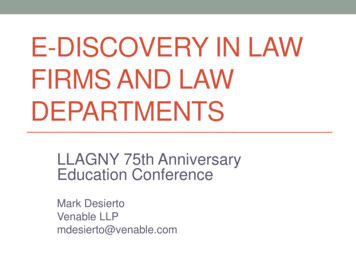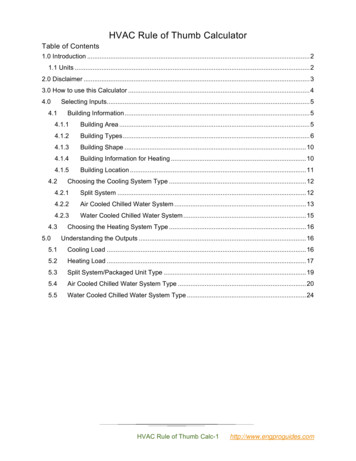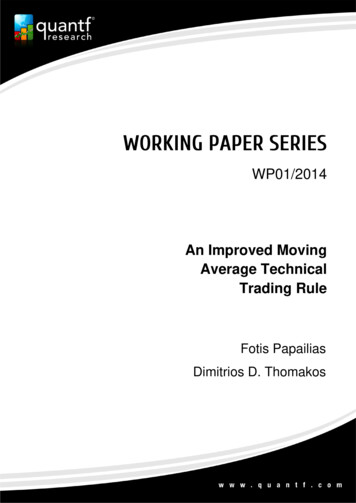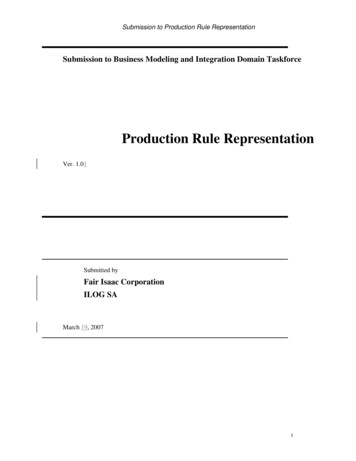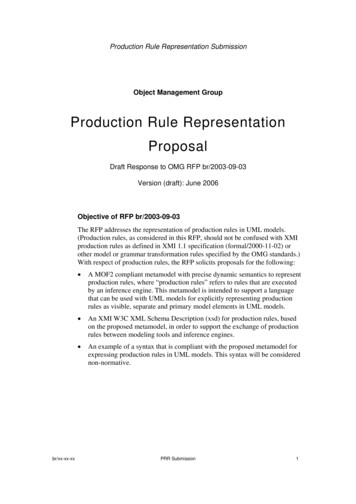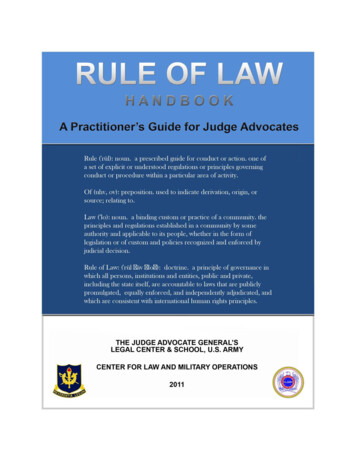
Transcription
RULE OF LAW HANDBOOKA PRACTITIONER’S GUIDE FOR JUDGEADVOCATES2011The Judge Advocate General’s Legal Center and School, U.S. ArmyCenter for Law and Military OperationsCharlottesville, Virginia y.smil.mil
The 2011 Rule of Law Handbook is dedicated to all those who promote the rule of law in the mostdifficult of circumstances, especially the members of the U.S. Armed Forces as well as ourinteragency and coalition partners.
RULE OF LAW HANDBOOKA PRACTITIONER’S GUIDE FOR JUDGEADVOCATES2011Although the Center for Law and Military Operations (CLAMO) publishes the Rule of LawHandbook, it is the product of contributions by dozens of authors from a multitude of agencies, bothU.S. and foreign, non-governmental and international organizations, military and civilian, over thecourse of several years. Due to its iterative nature, it would be difficult to list all those who havecontributed to the development of this, the fifth, edition of the Handbook. Official clearanceprocesses required by some agencies to ascribe individual authorship credit makes doing so even lesspractical. Suffice it to say, the current editor is indebted to the past and current contributors, and inparticular to the CLAMO 2011 interns who have helped bring this publication together.Editor: Lt Col Mike Cole, British ArmyCover design by 1LT B. Cox, U.S. Army JAGCThe contents of this publication are not to be construed as official positions, policies, or decisions ofthe United States Government or any department or agency thereof.
Rule of Law Handbook - 2011TABLE OF CONTENTSForeward .vPreface . . viiChapter 1: The Rule of Law: Conceptual Challenges .1I.Describing the Rule of Law .2A. Definitions of the Rule of Law .2B.A Definition of the Rule of Law for Deployed Judge Advocates .3C.Formalist v. Substantive Conceptions of the Rule of Law .9II.Rule of Law Operations .10A. Rule of Law Operations Within the Context of Full SpectrumOperations .11B.Operational Impact .14C.The Importance of Focusing on Effects .15Chapter 2: Key Players in Rule of Law .17I.U.S. Policy for Conflict Prevention and Response: InteragencyCoordination and Structure .17A. The Civilian Approach to Conflict Prevention and Response.19B.The Department of Defense Approach.20C.U.S. Agencies Influencing Stability Operations .21II.U.S. Governmental Agencies Involved in Rule of Law .26A. Department of State.26B.U.S. Agency for International Development .32C.Department of Justice.45D. Department of Defense.50E.United States Institute of Peace.57III. International Actors.58A. United Nations.59B.International Monetary Fund .61C.World Bank .62D. The North Atlantic Treaty Organization .64E.Non-Governmental Organizations .65F.Coalition Partners.67Chapter 3: The International Legal Framework for Rule of Law Operations .71I.Identifying a Rule of Law Legal Framework .71A. United Nation Mandates.71B.Mandates Pursuant to Bilateral and Multi-lateral Agreements .74C.Mandates Pursuant to National Legislation.75II.The Rule of Law Legal Framework .75A. The Law of War .75B.Occupation Law .77C.Human Rights Law.79III. Conclusion .82Chapter 4: The Institutional and Social Context for the Rule of Law .83I.Legal Institutions.83i
Rule of Law Handbook - 2011A. Legislatures. 83B.Courts. 84C.Police . 89D. Detention and Corrections . 91E.Military Justice . 93II.Civil Law Systems. 95A. The Civil Law Ideal of Separation of Powers . 95B.Specific Aspects of Civil Law . 96III. Religious Legal Systems and Sharia. 99A. The Sharia . 100B.The Application of the Sharia . 101C.The Substantive Sharia . 101D. International Law and Jihad . 102E.Sunnis and Shiites . 103F.Conclusion . 104IV. Combined Systems . 104V. Recognized Alternatives to the Formal Court System. 105A. Mediation. 105B.Arbitration. 106C.Customary, Traditional, or Informal Justice . 106D. Truth and Reconciliation Commissions . 107E.Property Claims Commissions. 108VI. The Implications of Gender for Rule of Law Programs . 109VII. Civil Society . 112A. Operational Objectives for Engaging, Leveraging, and SupportingCivil Society . 113B.How to Engage with Civil Society in Rule of Law. 113C.Conducting a Baseline Assessment in this Sector . 114D. Common Challenges and Lessons Learned to Guide Implementation . 116VIII. Non-State Security Providers . 117A. Risk Assessment and Analysis . 118B.Assessing the Role of Non-State Security Providers . 118C.Ten Lessons Learned . 120Chapter 5: Planning for Rule of Law Operations. 123Interagency Reconstruction and Stabilization Planning Framework. 123I.A. Introduction. 123B.The State Department’s Five-Sector Framework for Reconstructionand Stabilization . 124C.Military Primary Stability Tasks. 126D. The Interagency Planning Framework: Concluding Thoughts . 128II.Military Planning . 128A. Why Planning is Critical . 128B.What is Planning? . 129C.The Military Decision Making Process . 130D. Military Planning and Rule of Law Operations: Some Final Thoughts . 140III. Planning to Deploy . 141A. Pre-deployment Planning (D minus 180 to 30) . 141B.Initial Deployment Planning (D minus 30 to plus 90) . 147C.Sustained Deployment Planning (D plus 91). 153IV. Conducting Initial Situation Analysis / Baseline Assessment . 155ii
Rule of Law Handbook - 2011V.A. The Data Collection Phase .156Beginning the Running Estimate: Metrics .170A. Developing Metrics .172B.U.S. Institute of Peace: Measuring Progress in Conflict EnvironmentsMetrics Framework .177C.Interagency Conflict Assessment Framework .185D. Counterinsurgency Advisory and Assistance Team (CAAT) operatingin support of COMISAF.185E.The United Nations Rule-of-Law Tools for Post-Conflict States:Monitoring Legal Systems .186F.Gathering the Data .186G. Conclusion.187Chapter 6: Fiscal Considerations in Rule of Law Operations .189I.Purpose.191A. Introduction .191B.General Prohibition on Retaining Miscellaneous Receipts andAugmenting Appropriations.191II.Operational Funding, Foreign Assistance, and Rule of Law Activities .193A. Foreign Assistance Generally.193B.Foreign Assistance Specific Limitations .194III. Department of State Appropriations for Rule of Law Activities .195A. Economic Support Fund .195B.Bureau of International Narcotics and Law Enforcement Affairs .198IV. Department of Defense Appropriations for Rule of Law Operations .199A. Afghanistan Security Forces Fund / Iraq Security Forces Fund.200B.Commander’s Emergency Response Program .201C.Iraqi Funded Commander’s Emergency Response Program.203V. Funding Rule of Law Through Provincial Reconstruction Teams.204A. Provincial Reconstruction Teams and Embedded ProvincialReconstruction Teams .204B.Funding Rule of Law Operations via PRTs, ePRTs and other CMOs .205Chapter 7: Theater-Specific Information on Rule of Law: Afghanistan and Iraq .207I.Afghanistan .207A. Overview .207B.The Plans for Rule of Law .207C.The International Framework.210D. U.S. Government Efforts.211E.Provincial Reconstruction Teams .215F.The Legal System of Afghanistan .217G. Successful Rule of Law Practices in Afghanistan.225H. References and Further Reading .225II.Iraq .227A. International Framework .227B.U.S. Rule of Law Efforts: Transition from Military to Civilian Lead.227C.Current U.S. Rule of Law Strategy – Implemented ThroughInteragency Rule of Law Coordination Center (IRoCC) .228D. The Way Forward.231E.Iraqi Criminal Law and Criminal Procedure .232F.Security Agreement .238iii
Rule of Law Handbook - 2011G.H.Engaging Iraqi Judges. 239References and Further Reading . 242Chapter 8: Human Terrain Teams: An Enabler for Rule of Law Judge Advocates and Paralegals . 245I.Introduction . 245II.Background. 246III. Why Use a Human Terrain Team? . 247IV. How a Human Terrain Team Might Be Employed . 248Chapter 9: Rule of Law Narratives . 251I.Justice – A Centre of Gravity Analysis . 251II.Finding Help in the Right Places for a Counterinsurgency Strategy . 257III. National Security Prosecutions in Afghanistan . 260IV. When Mars and Venus Align: The Next Step in Interagency Cooperation. 268V. The Rule of Law at Dawn: A Judge Advocate’s Perspective on Rule ofLaw Operations in Operation Iraqi Freedom from 2008 to 2010 . 272Appendix A: The Rule of Law and Judge Advocates: A Short History . 285I.Rule of Law as the Foundation of the United States . 285II.Rule of Law Efforts in the Philippines and Cuba (1898-1902) . 286III. Rule of Law Efforts in Germany and Japan (1945-1950) . 288IV. Rule of Law Efforts in Southeast Asia (1964-1973) . 289V. Rule of Law Operations in Afghanistan and Iraq (2001 to present). 290Appendix B: Rule of Law Training . 293Appendix C: Acronyms . 299iv
Rule of Law Handbook - 2011FOREWORDRule of Law practitioners around the world have relied on this Handbook for almost five years now.In fact, I have found this volume used by both civilian and military rule of law practitioners frommany agencies across Afghanistan. Rule of law operations are conceptually difficult and hard toconvert into tangible successes on the ground. This handbook has helped to make such operationseasier to understand and execute. No other single volume has been as complete a reference formilitary and civilian practitioners alike.This year, the staff that worked so hard to produce this volume reflects the multi-national nature ofrule of law efforts today. British Army Lieutenant Colonel Mike Cole has gathered an outstandingand diverse group of military, civilian, and international experts to update the 2011 version of theRule of Law Handbook. I’ve known Mike since 2008, when he served on a multi-national andinteragency assessment team for rule of law to advise on coalition strategy in the Central Commandarea of responsibility. He performed rule of law work in Afghanistan’s Helmand Province and in arange of assignments involving rule of law planning and academics. He exemplifies the knowledgeand practical orientation of the many contributors to this year’s handbook. He and his team havebrought that expertise together to produce an outstanding handbook.Although the rule of law in Afghanistan remains mostly just a goal, it is an indispensable goal. It alsorequires more than high sounding ideals—organization, resources, people, time, concepts, and muchhard work are required to make progress in this critical line of effort. Over the past year, we haveseen extraordinary advances in military efforts to support rule of law. In September 2010, theChairman of the Joint Chiefs of Staff activated the U.S. Rule of Law Field Force-Afghanistan. OnJuly 4, 2011, the Commander of the International Security Assistance Force, the NATO SeniorCivilian Representative to Afghanistan, and the Deputy Minister of Justice of Afghanistan presidedover the activation of the NATO Rule of Law Field Support Mission in Kandahar. As thecommander for both these units, I know that my staff and key leaders relied on the Rule of LawHandbook as they addressed thorny problems confronting governance and rule of law here.Rule of law development is particularly important to the “comprehensive civil-military approach”adopted by NATO and ISAF members at Lisbon in order to set conditions for transition of securityresponsibility to the Afghan government. As General David Petraeus has emphasized repeatedly,delivery of dispute resolution is a key sector in which the Taliban competes effectively with theAfghan government. The Judge Advocate General’s Legal Center and School and the Center for Lawand Military Operations help prepare our ranks to confront this challenge. And confront it we must,because stability in Afghanistan is critical to security in the region and throughout the globe.I look forward to seeing the 2011 Rule of Law Handbook on bookshelves in far flung locations overthe coming year. The need to strengthen the rule of law will exist wherever people and theirgovernments cope with conflict and instability. Whether you are reading this handbook out ofacademic curiosity or because you are working in this area, I trust you will appreciate it for the firstclass reference book that it is. Good luck!Brigadier General Mark S. Martins, USACommanderNATO Rule of Law Field Support Mission &Rule of Law Field Force-AfghanistanKandahar, AfghanistanvForeword
Rule of Law Handbook - 2011PREFACEAmerica’s commitment to the rule of law is fundamental to our efforts to build an international1order that is capable of confronting the emerging challenges of the 21st century.This is the fifth edition of the Rule of Law Handbook published by the Center for Law and MilitaryOperations (CLAMO) at The Judge Advocate General’s Legal Center and School (TJAGLCS).Much has changed since the publication of the first volume in July of 2007. At that time, “surge”operations in Iraq had just begun and the eventual outcome of that tremendous commitment ofresources was far from certain. The fight in Afghanistan, while no less important, drew relativelylittle public attention.Four years on, the violence in Iraq has dropped precipitously, allowing the Iraqi people to assert theirrightful sovereignty in very real and dynamic ways. American forces have redeployed from Iraqicities, ended their combat mission, and commenced Operation New Dawn. Their presence in Iraq isnow subject to the terms of the US-Iraqi Security Agreement. 2 Afghanistan has, for some time now,been at the forefront of public attention as it experienced its own surge of resources designed to moveit along a similar path to success.Throughout these changes, judge advocates and their joint, interagency, intergovernmental andmultinational (JIIM) partners have quietly gone about advancing the rule of law (ROL) in theselocations and others. 3 In time, our military commitments in Iraq and Afghanistan will end. And so, itis fair to ask if there is still a need for judge advocates to concern themselves with rule of lawmissions, current or future? To answer anything other than “Yes!” would be shortsighted 4 andunrealistic given our history and hopes for the future. It would also condemn us to repeating pastmistakes, forgetting lessons learned, and weakening the strong JIIM relationships that we have builtalong the way.When called upon to conduct ROL operations, a judge advocate’s response must be effective and,more so now than ever, economic. Although recent experiences will inevitably inform that response,judge advocates must also be agile and innovative in their thinking, planning and execution to ensurethat their response meets these requirements. The battle for resources will become all the moreconsuming. As such, the design of ROL operations that make the best use of all available resources,from wherever they may come, is likely to be a critical factor in the efficacy of future endeavors inthis field, and the overall success of the military mission. NATO’s Rule of Law Field SupportMission is a perfect example of how the U.S. led Rule of Law Field Force – Afghanistan (ROLFF-A)has leveraged NATO resources to enhance the overall efficacy of its ROL mission.We are well past the conflict stage in Kosovo, yet judge advocates are still there participating in ruleof law missions in welcome partnership with civilian practitioners. 5 It is no doubt the hope of all1The White House, National Security Strategy, 37 (May 2010), available s viewer/national security strategy.pdf (last visited July 27,2011).2Id. at 25.3See infra Appendix A, “The Rule of Law and Judge Advocates: A Short History”.4See, e.g. Center for Law and Military Operations, Brigade Judge Advocate Symposium Report, at 5 (May2010) (“ROL is one area where JAs [judge advocates] have the opportunity to act as a force multiplier, insteadof simply fulfilling their traditional advisory role.”), available athttps://www.jagcnet2.army.mil/8525751D00557EFF (Army Knowledge Online authentication required).5Task Force Falcon, 40th Infantry Division, California National Guard, Office of the Command JudgeAdvocate, After Action Report, Kosovo Forces 11, Deployed February 2009 – November 2009, at 6 (9 January2010) (“Trainers actively discouraged participation in ROL activities for fear the unit might step on the toes ofviiPreface
Rule of Law Handbook - 2011ROL practitioners that the environments in Iraq and Afghanistan will, one day, be similarly benign soas to make ongoing rule of law efforts there “un-newsworthy.” Such an environment should not beseen as diminishing the value of that work. Indeed, given that successful ROL operations have thepotential to prevent conflict breaking out, it may be that we should actively plan to increase ROLactivities in not only the post-, but also the pre-conflict phase of stability operations. 6While rule of law efforts may become more or less newsworthy depending on the circumstances inwhich they are conducted, their conceptual value remains constant. Anyone who doubts that pointneed only look to the fourteen references to “rule of law” in the 2010 National Security Strategy, oneof which describes the rule of law as an “essential [source] of our strength and influence in theworld.” 7 If you value the role that judge advocates play in helping maintain that strength andinfluence, then read on.The 2011 EditionLike the 2010 edition, this edition of the Handbook is not a complete re-write of the one before it.That said, it does contain new material, updates and improvements throughout. Many members of theJIIM ROL community have devoted time and effort to ensuring the sections describing their work andspheres of influence are current. As ever, CLAMO is deeply in their debt for those contributions.Some chapters, by their nature, require updating every year; others do not. Funding sources andauthorities change from year to year, and sometimes even more often. A Fiscal Law instructor atTJAGLCS has previously remarked “It’s all theoretical until you figure out how to pay for it.” Thatsentiment is equally as well expressed, albeit in a less eloquent but perhaps more catchy manner, bythe refrain, “Show me the money!” in the film, Jerry McGuire. Given that any ROL program, nomatter how modest, will need to b
Although the Center for Law and Military Operations (CLAMO) publishes the Rule of Law Handbook , it is the product of contributions by dozens of authors from a multitude of agencies, bo
